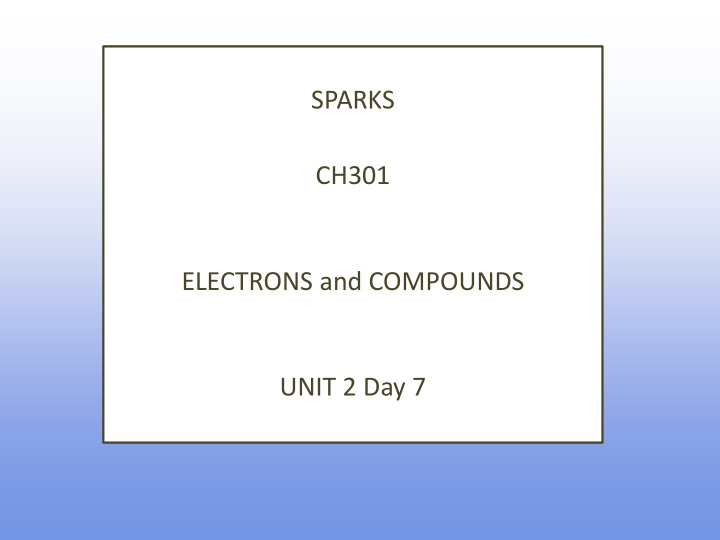



SPARKS CH301 ELECTRONS and COMPOUNDS UNIT 2 Day 7
What are we going to learn today? Electron Configuration and Bonding • Master using Lewis structures to predict bonding in compounds
INDIVIDUAL QUIZ: CLICKER QUESTION Referring to the position of Sr and P on the periodic table, would you predict these elements would come together to: A) Form a metallic compound B) Form a covalent compound C) Form an ionic compound
Relate electron configuration to periodic table
IONIC BONDING: SUMMARY Electrons transferred from one element to another Forms lattice of anions (negative ions) and cations (positive ions) held together by a (strong) electrostatic attraction
Consider bonding of identical non-metal atoms: H 2 • No incentive for either to gain or lose electrons
COVALENT bonding Atoms share valence electrons with other atoms to try to attain noble gas configurations. • The two nuclei REPEL • The electrons REPEL • BUT...the electrons are ATTRACTED to both nuclei!
Covalent Compounds Characterize the bond…. Bond Length Bond Strength Electron Pair Shared Equally? YES – PURE COVALENT NO – POLAR COVALENT
Electronegativity: electron pulling power of an atom when it is part of a molecule • When one atom is more electronegative than another in a bond, a polar covalent bond is formed. • Degree of polarity is dependent on difference in electronegativities .
Ionic vs Covalent Bonds All bonds can be viewed as hybrids between purely ionic and purely covalent (a) X and Y have identical ENs. (b) X and Y have dissimilar ENs. (c) X and Y have very different ENs.
Continuum of bonding types *For your reading later* • All bonds can be viewed as hybrids between purely ionic and purely covalent • When two identical atoms are bound, it is purely covalent. • When two different atoms are bound, one may have a greater attraction for electrons, and have a partial negative charge. • Polar covalent bond – degree is measured as dipole moment • When one atom has a much stronger attraction to the electrons than the other, an electron may be donated yielding an ionic bond.
POLLING QUESTION Which of the following bonds would you expect to be classified as polar covalent? KF CO O 2 A. KF, with the F end having a partial negative charge. B. KF, with the K end having a partial negative charge. C. CO, with the O end having a partial negative charge. D. CO, with the C end having a partial negative charge. E. O 2 , with neither end having a partial negative charge.
Covalent Compounds - Naming
Covalent Compounds What is attached to what? Valence electrons – Lewis symbols – Lewis Structure – Satisfy the Octet H 2 CH 4
LEWIS STRUCTURE RULES Determine total number of valence electrons Predict total number of Bonds : S = N – A rule Draw Skeletal Structure Place nonbonding electrons Fix the number of bonds
Demonstrate using the rules to show how to put together Lewis structures. CH 4 C 2 H 6
Examples from Activity C 2 H 4 C 2 H 2
Take a little moment…. Bond Strength Bond Length Single Double Triple
Examples 4, 5 and 6 from Activity C 2 H 6 O CH 3 OCH 3 C 2 H 5 OH
Hints for Lewis Dot structures 1. C almost always has 4 bonds and NO lone pairs 2. H always forms ____ bond 3. Halogens tend to form ____ bond. 4. How many bonds do you think C, N, and O often have?
What have we learned? ATOMS BEHAVE IN CERTAIN PREDICTABLE WAYS WHICH CAN BE CORRELATED TO THE ELECTRON CONFIGURATIONS SATISFYING THE OCTET RULE IS A SOLID PREDICTOR OF BONDING IN IONIC AND COVALENT COMPOUNDS
Learning Outcomes Draw the Lewis structures for molecular compounds and ions. Use Lewis structures to predict and explain the relative bond Strength and lengths in compounds. Recognize and apply exceptions to the octet rules.
Important Information HW due Monday. Want more help? Non-graded LM: Laude LM Lecture 8
Recommend
More recommend